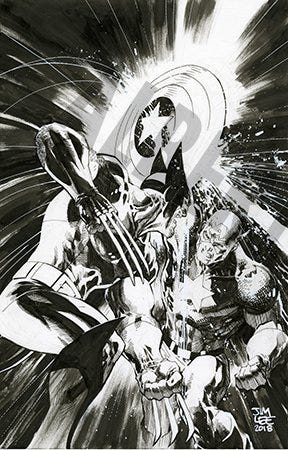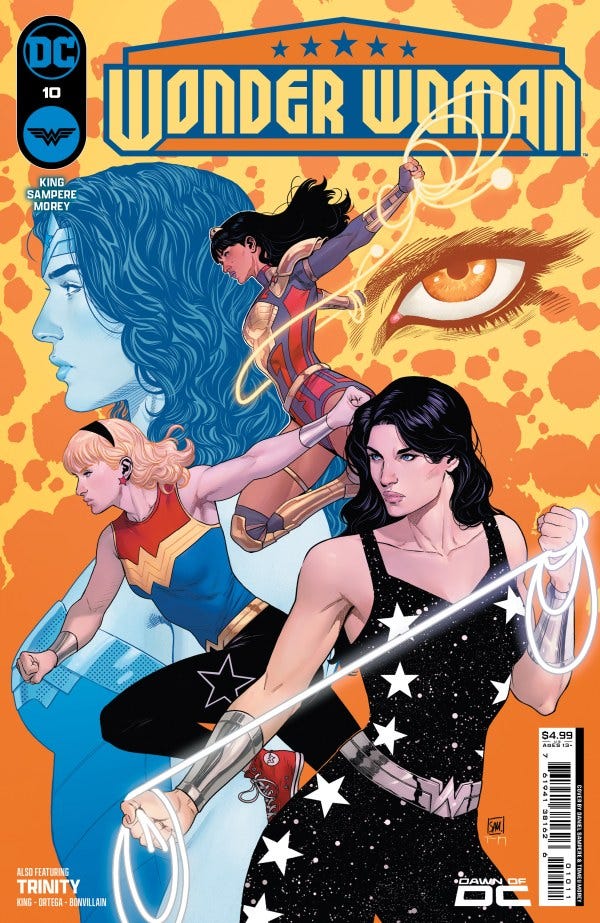The Jim Lee Discourse Shows Yet Again That Comic Fans Don't Respect Their Own Medium
The disclosure of comics legend Jim Lee's commission rates caused quite the uproar, but the fans' anger hides a darker truth that is holding the industry back.
Earlier in July, Albert Moy, legendary comic artist Jim Lee’s agent, posted that “for the first time in over 15 years, Jim Lee will be taking commission requests to be delivered exclusively [to] almost all shows he is appearing.” The costs for these penciled and inks originals was broken down as follows:
11 by 17 inches, full figure one character with limited backgrounds for $20,000, if more than one character or extra backgrounds or recreation of other covers not drawn by Jim will be $25,000 to $35,000
9 by 12 inches, waist on up figure with limited backgrounds is $9,000 to $15,000, will have backgrounds and more you pay can have other characters or scenes.
small head shot, sample is shown, $1000. Size is 3.25 by 7 inches and side profile only.
Blank cover comic, only bust shot with no background $8,000. And 12k if it a wraparound. Jim Lee will supply the blank cover comic but you can supply at the show if you like.
Now, if you are not a comic fan, you might look at these numbers aghast. $20,000? That is a lot of money to put down for a piece of comic art, no matter how great it is. And to the uninitiated, that would sound like a reasonable argument.
But consider Jim Lee’s history and standing in the comics community. Lee started out as a Marvel artist in 1987 on some mid-tier titles before moving to Uncanny X-Men with writer Chris Claremont, where he co-created fan-favorite Gambit/Remy LeBeau. From there, he launched 1997’s adjectiveless X-Men series. Issue #1 became the best-selling comic of all time at 8 million copies sold, while its iconic cover has lived on in the imagination of fans and fellow artists alike, earning various homages over the years. Lee’s X-Men designs were then used as the basis for X-Men: The Animated Series and played a large part in solidifying the series as the definitive take on the X-Men for a generation — an influence that can still be felt today with the animated X-Men ‘97.
From there, Lee went on to co-found Image Comics, now the third-largest comic book publisher in the industry, which produced books like The Walking Dead, Bone, Spawn, Invincible and Saga.
But Lee did not stop there. In 1998, he started working for DC, doing art for books such as Batman: Hush and Justice League. Like the X-Men, his designs for DC’s greatest heroes became iconic and definitive, arguably only falling behind José Luis García-López’s art from the DC Comics Style Guide and the looks from the DC Animated Universe (DCAU), which included series like Batman: The Animated Series, Superman: The Animated Series, Justice League and Justice League Unlimited. He became publisher of DC Comics in 2010 and chief creative officer in 2018, both positions he still holds to this day.
All in all, Jim Lee is a legend. Asking him to illustrate an original piece of art is like asking Christopher Nolan to direct your wedding video, Slash to give you a guitar lesson or Aaron Sorkin to edit your college essay. No one would bat an eye if any of those items were listed at an auction for the prices Jim Lee is charging for his art. In fact, we would probably expect them to be higher.
But while non-comic book fans can be excused for their ignorance of Jim Lee, current readers cannot. And yet, when Moy posted Lee’s rates, fans across social media decried him for his high prices, saying they were not worth it or “ridiculous.” This is all despite Lee’s storied career which has given these same readers designs and stories that have influenced film and TV, let alone expanded the breadth of the comic book industry.
But then again, this should not be all that shocking.
For years, modern comic book readers have failed to provide comic artists the respect they deserve. They fail to mention the artists of their favorite books when speaking about them, often only highlighting the writer. While the situation has vastly improved among the journalistic class, it was not too long ago that comic reviews would often leave out the name of the artist entirely. Part of this is not readers’ fault. Writers often stick with a single book longer than artists, who usually need to take a couple of months off between issues to rest. And publishers don’t help either, often referring only to the writer’s name in the collected editions. (See here and here for a couple of examples.)
Still, readers should strive to surpass the efforts of the conglomerates that run the industry. After all, drawing a comic book is an extraordinary task that requires extraordinary talent. Month after month, some of the best artists in the world put together 24 to 32 pages of original art that is evocative, kinetic, stylish and dramatic — all while sticking to a script and presenting a coherent narrative. What other industry provides that level of talent and craft for $3.99 a month?

Of course, this is a generalization. There are many comic readers who give the artist the proper respect. And this does not mean comic artists cannot be criticized. Like any form of artistic endeavor, their work should be put under the microscope just as we do for film, music and art. But in order to do that — in order to have a healthy comics criticism culture — readers need to treat comic books as the art they are, which means leaving silly critiques like this behind.
It was not too long ago that the comic industry was subject to government attack and censorship. Now look how far it has come — with people willing to pay $20,000 just to get their hands on one original piece of art. Readers should be rejoicing at how much the industry has progressed and applauding those who continue to, not just do great work, but push the medium forward in new and exciting ways. For if we don’t recognize their talents, who will?
One Comic I Read This Week
Wonder Woman #10
Written by Tom King and Illustrated by Daniel Sampere and Belén Ortega
Speaking of great art, Daniel Sampere continues to mesmerize with Wonder Woman #10, which may be the strongest issue of his and writer Tom King’s run. Many artists have a tendency to slim down Diana to present a more feminized version of the character. But as a goddess who can go toe to toe with DC’s strongest, I prefer Sampere’s physically big Wonder Woman. She is intimidating but also presents a sense of calm, a perfect encapsulation of the character.
Sampere’s depiction of the battle between Wonder Woman and Cheetah/Barbara Minerva is ferocious, with the years of bloody history between these two characters on full display with every punch. And yet, he and King are able to move the relationship forward in the more quiet moments of the back half of the issue, hinting that this passionate hate may yet turn into something more.
King’s writing on Wonder Woman has varied issue by issue, as the narrations by the book’s overarching villain, The Sovereign, can be pretentious and hard to follow at times. But it works wonders here, as King continues to define Wonder Woman both on her own terms and in comparison to the other members of DC’s Trinity — Batman and Superman.
Meanwhile, the Wonder Girls are absolutely delightful, with their playful banter offering a respite from the heaviness of the A-plot of the story. The dialogue feels quick and natural, while Sampere’s depiction — or lack thereof — of the Invisible Jet only elevates the gag to new heights.
Finally, the backup story by King and Belén Ortega is especially charming this issue, with Wonder Woman’s daughter, Lizzie, learning how to fly a kite. Ortega’s expressive art really sells Lizzie’s struggle in a way that is both comedic and completely validating of the tragicomedy of Lizzie’s failed efforts. Meanwhile, the bickering between Jon and Damian gives me a chuckle every time I read it, with King bringing a good sense-of-levity to these slice of life adventures. The inclusion of Kite Man at the end is the cherry on top of what was a stunning issue overall. Hell yeah, comics are great.








